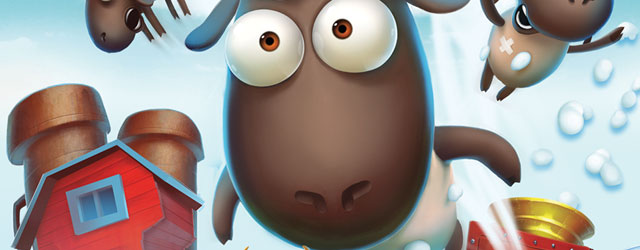[tab:Review]
Funky Farm is a WiiU launch title and simulation farm game. Players have the option of building their own farm or taking part in challenge mode. The introduction of the former starts with a slide show of Farmer Rufus’s life as a creator of robotic farm equipment. He gets sick one winter, only to pass away and leave the farm to you in his will.
Your first farm has a tutorial that walks you through all of the controls and functions of the game. Most of the controls use the screen on the game pad and stylus by default. Your main buttons are the right trigger (grab and drag), the A button (use/accept), and the B button (cancel). This can be very frustrating going between stylus and buttons, making the game pad use feel forced. For anyone who spends the majority of their game time on other consoles, the controls feel very unnatural.
The game is a typical simulation that has players managing managing resources to try and get bigger and better items to get more resources. You start with chickens that lay eggs, and the eggs are what you sell to make money. Later, you’ll advance to sheep/wool, cows/milk, trees/fruit etc. Of course, your animals have to be happy or farm protective services will remove them from your custody. Actually, they leave of their own accord. You can raise their mood by keeping them well fed, watered and sheltered, and they produce bubbles above their head telling you what they need or want. There is also the farmer hints button at the top of the screen that flashes, giving tips about what your animals need and other game play mechanics. For a quick fix to your animal’s mood, you can pet the animal in question. As a result of the petting (performed with the stylus and Gamepad screen), not only will the mood increase, but it will cause them to produce nearly instantaneously.
Now, the engineering of Farmer Rufus really makes your life easier because of his funky creations. There are egg collectors, wool collectors, box and bale collectors and so forth. These machines go around harvesting your products and moving them to your selling bay (incidentally, another of the robotic creations). These machines allow you to focus your attention on more pressing matters. I wish there had been a feeding machine, but at least there was a short cut using the motion control of the game pad by tilting it forward then back to refill your troughs.
Another feature of the game is the ability to trade with other farmers. They give you a list of needed items, and in exchange, they give you money. These trades are timed. If you cannot produce the product in the allotted time frame, the trade expires. Completing trades does not advance your progress in any way except to provide more money.
The stork is how you acquire your animals. It runs on a counter, and as long as you’re not maxed out, you can select what type of animal you would like to have. I recommend keeping no more than 5 or 6 of each type. You get a larger allotment and more types of animals by leveling your farm up.
Completing objectives will level you up. These are comprised of a “to do” list, including things like build a decoration, plant “x” amount of trees, buy a certain machine, etc. A meter at the bottom of your game pad measures the progression of your level and quality of farm. By leveling up you can get new animals, structures, decorations and machines. I should mention that upgrading existing equipment is a must, as improved machinery will make managing tasks far easier.
There are obstacles to overcome that I found aggravating. Storms, tornados and pests stop progress or even set you back, forcing you to rebuild for example. The pests are less frustrating mainly because you just have to move the animal being attacked. A mushroom acts in a similar way; if it’s the wrong color for the wrong animal, it causes illness. Just pick the animal up and shake it. On the other hand the right color for the right animal can cause a higher production rate.
The challenge mode gives you a specific circumstance to overcome to clear the stage. The first stage is a partially destroyed farm with unhappy animals that you have to repair and make happy in a 20 minute time frame. If you succeed, you move on to the next stage. There are three stages in all.
Overall, there is nothing broken in the game. It accomplishes what it set out to do. As far as a simulation goes, it is decent, maybe even bordering on good. However the price point is a real hang up for me. At $50, it is not worth a purchase, considering there are better, much less expensive simulation games out there for other platforms. If this was in the $20 – $30 range, it might be a good fit for those that are diehard fans of the genre.
Review copy of game provided by publisher.
[tab:Screenshots]
[tab:END]


